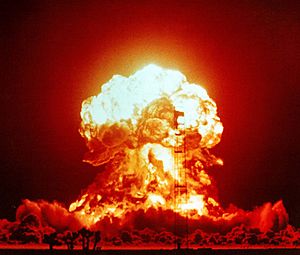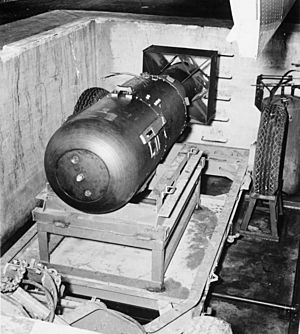Nuclear weapon facts for kids
A nuclear weapon, also known as a nuclear bomb or a nuke, is a powerful weapon that releases a huge amount of energy. This energy comes from the center, or nucleus, of certain types of atoms. When a nuclear weapon is set off, it creates a massive nuclear explosion.
Nuclear explosions can destroy entire cities and harm many people. They also create something called nuclear fallout. This fallout is radioactive material that can make people very sick, even long after the explosion. Nuclear weapons are the most destructive weapons ever made.
The United States built the first nuclear weapons during World War II. Two nuclear weapons were used to attack cities in Japan. These were the only times nuclear weapons have been used in war.
Today, the United States and Russia have the most nuclear weapons. Other countries that have them include China, France, United Kingdom, India, Israel, North Korea, and Pakistan. South Africa used to have nuclear weapons but chose to destroy them.
There are two main types of nuclear weapons:
- Fission weapons (also called atomic bombs or A-Bombs).
- Fusion weapons (also called hydrogen bombs, H-Bombs, or thermonuclear weapons).
They create energy differently. Fusion weapons cause much bigger explosions. Fission weapons use special types of uranium or plutonium. Fusion weapons use a special type of hydrogen.
Contents
History of Nuclear Weapons
Around 1895, scientists began to understand how atoms are made. By 1915, people started thinking that breaking apart certain atoms could release a lot of energy. This energy could then be used to make a bomb.
In 1939, scientists understood the idea behind nuclear fission weapons. However, no country knew how to build one yet. When World War II began, Germany, the United Kingdom, and the United States all wanted to build nuclear weapons. Germany did not finish its project. Many top scientists had left Germany after Nazi rule started.
The United Kingdom started its own work in 1939. But it cost too much money, so they stopped in 1942. Later that year, the United States began a very large project to build nuclear weapons. This project used the work already done in the United Kingdom. It was called the "Manhattan Project".
By August 1945, the Manhattan Project had built three nuclear fission weapons. The United States used two of these bombs to attack the cities of Hiroshima and Nagasaki in Japan. Experts from the Manhattan Project believed that about 105,000 people were killed and 94,000 were hurt right away. Later, medical experts thought that more than 225,000 people died in total, including those affected over a long time. Japan announced its surrender after these bombings.
After World War II, the Soviet Union also started working to create nuclear weapons.
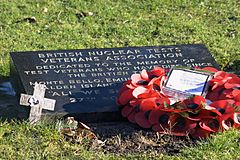
Types of Nuclear Weapons
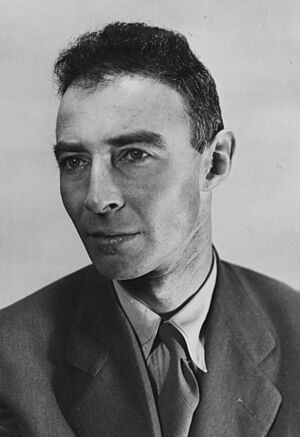
There are two main kinds of nuclear weapons:
- Those that get most of their energy from nuclear fission reactions only. These are like the first atomic bombs.
- Those that use fission reactions to start nuclear fusion reactions. These fusion reactions then create a huge amount of the total energy.
There are also other types. For example, a boosted fission weapon is a fission bomb that gets more explosive power from a small number of fusion reactions. But it's not a full fusion bomb. In a boosted bomb, the fusion reactions mainly help the fission bomb work better.
How Nuclear Weapons Work
One way nuclear weapons release energy is by breaking atoms apart. This process is called nuclear fission and is the basis for atomic bombs. Special types of uranium or plutonium are usually used. These elements can be made to undergo fission and create a chain reaction. This means one atom breaking apart causes others to break apart, releasing more and more energy.
Another process can be used to make nuclear weapons that create even bigger explosions. These weapons release much more energy by joining atoms together. This process is called nuclear fusion. Weapons based on this are called hydrogen bombs or thermonuclear weapons. Special types of hydrogen are typically used in these weapons.
Nuclear weapons produce a huge amount of energy and radiation. This can harm people or animals several kilometers away. Most of the radiation is X-rays, which heat the air to create a giant nuclear fireball. This fireball expands very quickly, making a dangerous shock wave. This wave can destroy buildings many kilometers away. The radiation can cause radiation sickness and can also damage DNA, which might lead to cancer later on.
Nuclear bombs also release fallout. This is radioactive material and dust that has been made radioactive by the explosion. Over time, this fallout can harm people farther away, depending on how much was released. Wind can carry radioactive fallout long distances from the explosion site. It can stay dangerous for a long time.
A hydrogen bomb, also known as a fusion bomb, uses hydrogen isotopes (like deuterium and tritium) along with uranium or plutonium. Hydrogen bombs can be much more powerful than fission bombs.
Making Nuclear Weapons
Nuclear weapons are hard to build. They require special isotopes of uranium or plutonium. They also need very advanced technology. This is why only a few countries have nuclear weapons. When countries that don't have nuclear weapons create their own, it's called nuclear proliferation.
Delivering Nuclear Weapons
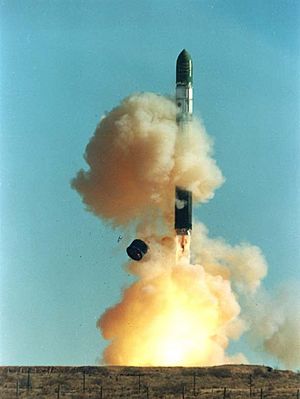
Getting a nuclear weapon to its target can be as difficult as making one. The explosive material can be put into a bomb, an artillery shell, or a missile. When a nuclear device is placed on a missile, it's called a nuclear missile.
Nuclear missiles can be carried by airplanes, submarines, or trucks. They can also be stored in underground missile silos. Some airplanes like the Boeing B-29 Superfortress, Convair B-36 Peacemaker, Boeing B-52 Stratofortress, and Northrop Grumman B-2 Spirit have carried nuclear weapons.
Missiles like intercontinental ballistic missiles (ICBMs) or submarine-launched ballistic missiles (SLBMs) also carry them. Some missiles travel to the edge of space. Then, they release several separate nuclear weapons. Each weapon can travel to a different target. This is called a MIRV Warhead, which stands for Multiple Independent Reentry Vehicles. Very large nuclear bombs have been made. But in reality, a weapon with multiple warheads can cause more damage by hitting many targets.
Making nuclear weapons takes many resources. The materials are rare, and many scientists are needed. But several countries have managed to create them. The countries that have nuclear weapons are:
- United States (1945)
- Russia (1949)
- United Kingdom (1952)
- France (1960)
- China (1964)
- India (1974)
- Pakistan (1998)
Some countries are thought to secretly have or be developing nuclear weapons. Other countries used to have them but have since gotten rid of them.
Some countries have even lost nuclear weapons during transport. There are at least 92 known cases of atomic bombs being lost at sea.
Major Nuclear Explosions
This list shows some of the most important nuclear explosions that have happened. It includes the bombings of Hiroshima and Nagasaki. It also includes the first nuclear test of a certain weapon type for a country. Plus, it lists other important tests, like the largest one ever. The "Yield" means the explosive power, measured in kilotons of TNT.
| Date | Name | Yield (kT) | Country | Significance |
|---|---|---|---|---|
| 1945-07-16 | Trinity | 18–20 | USA | First test of a fission device. |
| 1945-08-06 | Little Boy | 12–18 | USA | Bombing of Hiroshima, Japan. First use of a nuclear weapon in war. |
| 1945-08-09 | Fat Man | 18–23 | USA | Bombing of Nagasaki, Japan. Second and last use of a nuclear weapon in war. |
| 1949-08-29 | RDS-1 | 22 | USSR | First fission weapon test by the USSR. |
| 1952-10-03 | Hurricane | 25 | UK | First fission weapon test by the UK. |
| 1952-11-01 | Ivy Mike | 10,400 | USA | First test of a fusion (hydrogen) weapon. |
| 1952-11-16 | Ivy King | 500 | USA | Largest pure-fission weapon ever tested. |
| 1953-08-12 | Joe 4 | 400 | USSR | First fusion weapon test by the USSR. |
| 1954-03-01 | Castle Bravo | 15,000 | USA | First dry fusion weapon test. Caused a serious nuclear fallout accident. Largest US nuclear test. |
| 1955-11-22 | RDS-37 | 1,600 | USSR | First deployable fusion weapon test by the USSR. |
| 1957-11-08 | Grapple X | 1,800 | UK | First successful fusion weapon test by the UK. |
| 1957-05-31 | Orange Herald | 720 | UK | Largest boosted fission weapon ever tested. |
| 1960-02-13 | Gerboise Bleue | 70 | France | First fission weapon test by France. |
| 1961-10-31 | Tsar Bomba | 57,000 | USSR | Largest thermonuclear weapon ever tested. |
| 1964-10-16 | 596 | 22 | PR China | First fission weapon test by China. |
| 1967-06-17 | Test No. 6 | 3,300 | PR China | First fusion weapon test by China. |
| 1968-08-24 | Canopus | 2,600 | France | First fusion weapon test by France. |
| 1974-05-18 | Smiling Buddha | 12 | India | First nuclear explosive test by India. |
| 1998-05-11 | Pokhran-II | 60 | India | First potential fusion/boosted weapon test by India. |
| 1998-05-28 | Chagai-I | 40 | Pakistan | First fission weapon test by Pakistan. |
| 1998-05-30 | Chagai-II | 20 | Pakistan | Second fission weapon test by Pakistan. |
| 2006-10-09 | 2006 North Korean nuclear test | ~1 | North Korea | First fission weapon test by North Korea. |
| 2009-05-25 | 2009 North Korean nuclear test | 2-6 | North Korea | First successful fission weapon test by North Korea. |
| 2013-02-16 | 2013 North Korean nuclear test | 7 | North Korea | Last nuclear test from Earth. |
Effects of Nuclear Explosions
Health Effects of Nuclear Explosions
Scientists believe that even a small nuclear war, with 100 bombs the size of the Hiroshima bomb, could cause millions of deaths. This would be due to long-term climate effects alone. If cities caught fire, a lot of smoke could go into the atmosphere. This smoke might block sunlight for years, leading to a "nuclear winter" and disrupting food supplies.
People who survived the Hiroshima explosion suffered many terrible health problems. Some of these problems are still present today.
- Initial stage: In the first few weeks, most deaths were from burns or the blast. Some were from very high radiation exposure.
- Intermediate stage: After a few weeks, deaths were mainly from radiation sickness.
- Delayed period: Over time, survivors faced many complications. These included problems with healing injuries. If exposed to a certain amount of radiation, people might have issues like infertility or blood disorders.
- Long-term effects: Radiation exposure can increase the chance of getting cancer later in life. Other problems like eye cataracts can also appear over time.
Exposure to fallout depends on what people do. If individuals stay indoors or move away from the fallout cloud, they can greatly reduce their exposure. Staying inside until the most dangerous radioactive material decays can help prevent serious health issues like Thyroid cancer.
Effects of Nuclear War
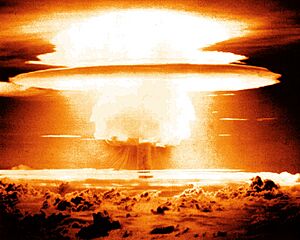
A nuclear war could cause a huge number of deaths and destroy natural environments. Setting off many nuclear weapons would have immediate and long-term effects on the climate. This could lead to cold weather known as a "nuclear winter".
In 1982, Brian Martin estimated that a nuclear exchange between the US and the Soviet Union could directly kill 400–450 million people. This would mostly happen in the United States, Europe, and Russia. Hundreds of millions more could die from later problems in those same areas. Many experts have suggested that a global nuclear war could lead to the extinction of the human race.
The International Physicians for the Prevention of Nuclear War believe that nuclear war could indirectly lead to human extinction. This would be through environmental problems, breakdown of society, and economic collapse. It has been estimated that even a small nuclear conflict between India and Pakistan involving 100 Hiroshima-sized bombs could cause a nuclear winter. This could lead to over a billion deaths.
A study in August 2022 suggested that a full nuclear war between the US and Russia could directly kill 360 million people. More than 5 billion people could die from starvation. A smaller nuclear war between India and Pakistan could still cause over 2 billion deaths.
People Connected to Nuclear Weapons
Here are some important people linked to nuclear weapons and related issues:
Images for kids
-
Edward Teller, often called the "father of the hydrogen bomb".
-
The former United States' Peacekeeper missile was an ICBM. Each missile could hold up to ten nuclear warheads (shown in red), each aimed at a different target.
-
Ukrainian workers taking apart a Soviet-era missile silo. After the Cold War, Ukraine and other former Soviet countries gave their nuclear weapons to Russia.
-
A protest in Bonn against the nuclear arms race between the U.S./NATO and the Warsaw Pact, 1981.
-
A demonstration against nuclear testing in Lyon, France, in the 1980s.
See also
 In Spanish: Arma nuclear para niños
In Spanish: Arma nuclear para niños


